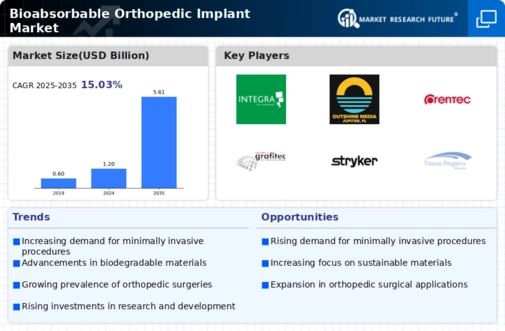The Bioabsorbable Orthopedic Implant Market is currently characterized by a dynamic competitive landscape, driven by innovation, technological advancements, and strategic partnerships. Key players such as DePuy Synthes (US), Stryker (US), and Medtronic (US) are at the forefront, each adopting distinct strategies to enhance their market positioning. DePuy Synthes (US) focuses on expanding its product portfolio through continuous innovation, while Stryker (US) emphasizes strategic acquisitions to bolster its capabilities in bioabsorbable materials. Medtronic (US), on the other hand, is investing heavily in digital transformation to streamline operations and improve patient outcomes. Collectively, these strategies contribute to a competitive environment that is increasingly centered around technological differentiation and enhanced patient care.
In terms of business tactics, companies are localizing manufacturing and optimizing supply chains to respond swiftly to market demands. The market structure appears moderately fragmented, with several players vying for market share. However, the influence of major companies is substantial, as they leverage their resources and expertise to shape industry standards and drive innovation. This competitive structure fosters an environment where smaller firms can thrive by focusing on niche markets or specialized products.
In August 2025, Stryker (US) announced the launch of a new line of bioabsorbable implants designed specifically for pediatric orthopedic applications. This strategic move not only diversifies Stryker's product offerings but also addresses a critical gap in the market, as pediatric patients often require tailored solutions. The introduction of these implants is likely to enhance Stryker's competitive edge and solidify its reputation as a leader in innovative orthopedic solutions.
In September 2025, Medtronic (US) unveiled a partnership with a leading technology firm to integrate artificial intelligence into its bioabsorbable implant design process. This collaboration aims to enhance the precision and efficacy of implants, potentially revolutionizing the way orthopedic surgeries are performed. By leveraging AI, Medtronic is positioning itself at the cutting edge of technological advancement, which could lead to improved patient outcomes and operational efficiencies.
In July 2025, DePuy Synthes (US) entered into a strategic alliance with a European research institution to develop next-generation bioabsorbable materials. This partnership is indicative of the company's commitment to innovation and research, as it seeks to enhance the performance and safety of its implants. Such collaborations are crucial in a market where technological advancements are paramount, and they may provide DePuy Synthes with a competitive advantage in the long term.
As of October 2025, the Bioabsorbable Orthopedic Implant Market is witnessing trends that emphasize digitalization, sustainability, and the integration of advanced technologies such as AI. Strategic alliances are increasingly shaping the competitive landscape, enabling companies to pool resources and expertise to drive innovation. Looking ahead, it is likely that competitive differentiation will evolve, with a shift from price-based competition to a focus on innovation, technology, and supply chain reliability. This transition underscores the importance of adaptability and forward-thinking strategies in maintaining a competitive edge in the market.


















Leave a Comment